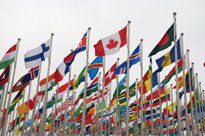
What Is a Cross Rate?
A cross rate is a foreign currency exchange transaction between two currencies that are both valued against a third currency. The U.S. dollar (USD) is the currency that’s usually used in foreign currency exchange markets to establish the values of the pair being exchanged.
As the base currency, the U.S. dollar always has a value of one. Some USD pairs are reciprocal and the dollar is not the base currency.
Two transactions are involved when a cross-currency pair is traded. The trader first trades one currency for its equivalent in U.S. dollars. The U.S. dollars are then exchanged for another currency.
Key Takeaways
- A cross rate can be any exchange of any two currencies that aren’t the official currency of the country in which the quote is published.
- Any currency exchange in which neither of the currencies is the U.S. dollar is considered a cross rate in practice.
- One of the most common cross-currency pairs is the euro and the Japanese yen.
- Foreign exchange traders use the term cross rate to refer to price quotes between any pair of currencies in which neither is the U.S. dollar.
Understanding the Cross Rate
The U.S. dollar is usually used to establish the value of each of the two currencies being traded. You would first determine that the British pound was valued at maybe 1.25 to one U.S. dollar and that the euro was valued at 1.07 to one U.S. dollar if you were calculating the cross rate of the British pound versus the euro,
The Major Currency Pair
Foreign exchange (forex) traders use the term cross rate to refer to price quotes between currencies in which neither is the U.S. dollar.
Most transactions on the forex are in major currency pairs. If one of the currencies being swapped is the U.S. dollar, it would mean that one U.S. dollar is equal to 1.28 Canadian dollars if you see on a financial news site that USD/CAD is quoted at 1.28.
A cross rate also refers to a currency pair or transaction that doesn’t involve the currency of the party initiating the transaction.
An exchange rate between the euro and the Japanese yen is considered to be a commonly quoted cross rate because it doesn’t include the U.S. dollar. But in the pure sense of the definition, it’s considered a cross rate if it’s referenced by a speaker or writer who isn’t in Japan or one of the countries that use the euro as its official currency.
The pure definition of a cross rate requires that it be referenced in a place where neither currency is used but the term is primarily used to reference a trade or quote that doesn’t include the U.S. dollar.
Examples of Major Cross Rates
Any two currencies can be quoted against each other but the most actively traded cross-currency pairs are the euro versus the British pound, or EUR/GBP, and the euro versus the Japanese yen, or EUR/JPY. These two pairs are the only cross-rate currency pairs that appear in the top 10 most traded currency pairs.
The euro is the base currency for the quote if it’s included in the pair. The British pound is the base if the pound is included but the euro is not.
Examples of Minor Cross Rates
Cross rates that are traded in the interbank market but are far less active include the Swiss franc versus the Japanese yen, or CHF/JPY, and the British pound versus the Swiss franc, or GBP/CHF.
Cross rates involving the Japanese yen are usually quoted as the number of yen versus the other currency regardless of the other currency.
Cross quotes in currencies that are similar in value and quoting convention must be posted carefully to prevent mistakes in trading. The New Zealand dollar (NZD) was quoted at 1.08 per Australian dollar (AUD) in late December of 2023. Both of these currencies are quoted against the U.S. dollar. The value reflects the number of U.S. dollars it would take to buy the foreign currency.
But the quote provides no guidance as to which is the base currency. The market convention is to use the stronger AUD, which is also the larger economy, as the base. The two currencies trade near parity to each other, however, creating the potential for a misquote.
What Is Reciprocal Currency?
Reciprocal currency is a term used in the foreign exchange market to denote a pair of currencies that includes the U.S. dollar. But the U.S. dollar isn’t used as the transaction’s base currency or the currency that’s initially quoted.
What Is the Foreign Exchange?
The foreign exchange is a market in which a foreign currency is traded for a domestic currency. The market deals only in currencies and not in other services or goods.
Does the Value of the U.S. Dollar Change Often?
Currency values aren’t carved in stone. They “float” and can change frequently due to various factors. You can’t buy as much foreign currency with the U.S. dollar when the dollar is weak.
The Bottom Line
The major crosses have bid-offer spreads that are slightly wider than the major dollar-based pairs but they’re quoted actively in the interbank market. Spreads in the minor crosses are generally much wider. Some are not quoted directly at all so a quote must be constructed from the bids and offers in the component currencies versus the U.S. dollar.
